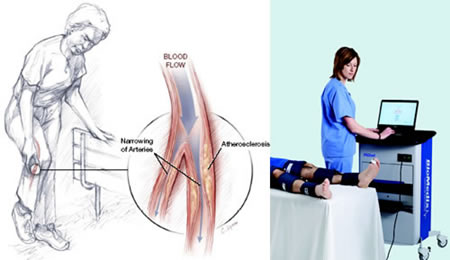
Our Services
Menu
Our Office
Clear Lake Office
1234 Bay Area Boulevard, Suite G
Houston, TX 77058
(281) 488-3237
Search
Peripheral Arterial Disease (PAD)
![]() What Is Peripheral Arterial Disease - PAD?
What Is Peripheral Arterial Disease - PAD?
The arteries are the blood vessels that carry the blood from the heart to all the areas of the body. Peripheral arterial disease (PAD) is a condition in which fatty deposits (called plaque) build up along the walls of the arteries that carry blood to the arms and legs. This is also known as arteriosclerosis or hardening of the arteries. The arteries slowly narrow and may even become blocked, affecting blood circulation, especially in the legs and feet.
Who Has It? - What Are The Signs Of Pad
- Cramping pains in the legs or hip muscles with walking, that stops during rest or feelings of numbness, weakness or heaviness of the legs with no pain can be a signs of PAD.
- Burning or aching in the feet and toes while at rest, particularly while lying flat
- Cooling of the skin in specific areas of the legs or feet
- Color changes in the skin, particularly in the arms or legs
- Sores (wounds or ulcers) on the feet and toes, especially ones that do not heal
- No pulses in the feet
(20-50% of patients with PAD have no symptoms - Peripheral Arterial Disease Coalition)
Who Is At Risk?
- Smoking is the number one risk factor for PAD and will interfere with treatment of the disease. People with PAD should stop smoking completely because even 1 or 2 cigarettes daily can affect treatment.
- Diabetes is a significant risk factor for PAD. People with diabetes should keep strict control of the their blood sugar to avoid serious problems resulting from PAD.
- Older age is a predictor for PAD. It occurs more frequently in those 60 years of age or older.
- People with a family history of heart disease are at greater risk for PAD.
 How Do You Test For PAD?
How Do You Test For PAD?
The first step is to perform a non-invasive vascular examination. This is a simple test done by placing blood pressure cuffs about the leg at different levels to measure the blood pressure and obtain a image of the pulse wave form. This will give your doctor an excellent idea of if there is evidence of PAD. Your doctor can then advise you if you need treatment or if further testing is necessary.
When Should You Be Tested For Pad?
If you have any of the six Signs of PAD you should have a non-invasive vascular exam.

Sources: American Heart Association., Center for Disease Control and Prevention, National Institute of Health, Society of Cardiovascular and interventional Radiology, Vascular Disease Foundation, World Health Organization
Useful links
Connect With Us
Contact Us
- Clear Lake Office
1234 Bay Area Boulevard, Suite G
Houston, TX 77058 - Phone: (281) 488-3237
- Fax: (281) 488-4218
Web Site Design & Maintained by Physician WebPages
